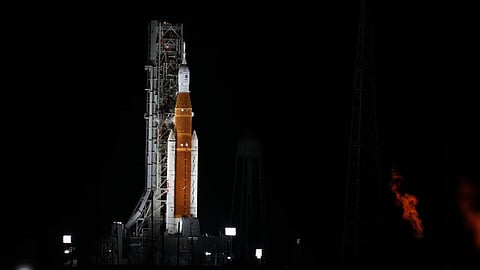

CAPE CANAVERAL: Fuel leaks and a possible crack discovered during final liftoff preparations threatened to delay the launch of NASA's mighty new moon rocket Monday morning on its shakedown flight with three test dummies aboard.
As precious minutes ticked away, NASA repeatedly stopped and started the fuelling of the Space Launch System rocket with nearly 1 million gallons of super-cold hydrogen and oxygen because of a leak.
The fuelling already was running nearly an hour late because of thunderstorms off Florida's Kennedy Space Centre.
The leak appeared in the same place that saw seepage during a dress rehearsal back in the spring.
Then a second apparent leak in a valve turned up, officials said.
Later in the morning, a crack or some other defect was spotted on the core stage the big orange fuel tank with four main engines on it with frost appearing around the suspect area, NASA officials said.
Engineers began studying the buildup.
The rocket was set to lift off on a mission to put a crew capsule into orbit around the moon.
The launch represents a major milestone in America's quest to put astronauts back on the lunar surface for the first time since the Apollo programme ended 50 years ago.
NASA's assistant launch director, Jeremy Graeber, said after the repeated struggles with the first leak that the space agency would have to decide whether to go forward with the Monday morning launch.
"We have a lot of work to get to that point," Graeber cautioned.
If Monday's launch can't go forward, the next attempt wouldn't be until Friday at the earliest.
The 322-foot rocket is the most powerful ever built by NASA, out-muscling even the Saturn V that took the Apollo astronauts to the moon.
No astronauts were inside the rocket's Orion capsule.
Instead, the test dummies, fitted with sensors to measure vibration, radiation and other conditions, were strapped for the six-week mission, scheduled to end with the capsule's splashdown in the Pacific in October.
Even though no one was on board, thousands of people jammed the coast to see the rocket soar. Vice President Kamala Harris was expected among the VIPs.
The launch is the first flight in NASA's 21st-century moon-exploration programme, named Artemis after Apollo's mythological twin sister.
Assuming the test goes well, astronauts will climb aboard for the second flight and fly around the moon and back as soon as 2024.
A two-person lunar landing could follow by the end of 2025.
The problems seen Monday were reminiscent of NASA's space shuttle era, when hydrogen fuel leaks disrupted countdowns and delayed a string of launches back in 1990.
Launch director Charlie Blackwell-Thompson and her team also had to deal with a communication problem involving the Orion capsule.
Engineers scrambled to understand an 11-minute delay in the communication lines between Launch Control and Orion that cropped up late Sunday.
Although the problem had cleared by Monday morning, NASA needed to know why it occurred before committing to a launch.
Visit news.dtnext.in to explore our interactive epaper!
Download the DT Next app for more exciting features!
Click here for iOS
Click here for Android